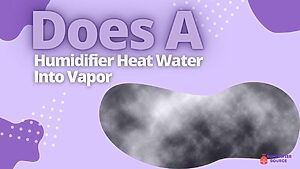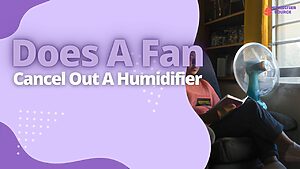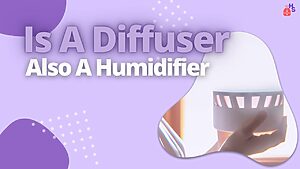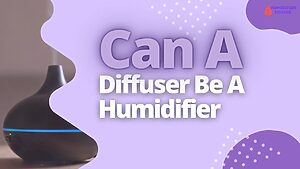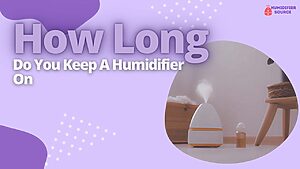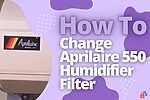Sometimes, ordinary items can be transformed into extraordinary things. Take, for example, a sponge. As a simple kitchen item, you might think it’s useless. But have you ever considered using a sponge as a humidifier filter? It’s amazing!
Humidifiers are amazing. They help you breathe better, they help you feel more relaxed, and help you sleep better at night. But they’re also pretty expensive.
That’s why many people use humidifier filters to cut down on the cost of their humidifiers. Isn’t it interesting that a kitchen sponge may be used as a humidifier filter? It’s true!
In this article, we’ll look at whether you can use a sponge as a humidifier filter and which things you should keep in mind.
Key Takeaway’s
- No, you should not use a sponge as a humidifier filter.
- Sponge filters can harbor bacteria and mold, which can be released into the air and cause respiratory problems.
- Instead, look for humidifier filters that are made of materials that can be easily cleaned and won’t harbor bacteria or mold.
- Some good options for humidifier filters include activated carbon, HEPA filters, and silver impregnated pads.
- Be sure to change your humidifier filter regularly to ensure optimal air quality.

Answer To Can I Use A Sponge As A Humidifier Filter
Yes. You can use a sponge as a filter. The sponge will remove the harmful particles from the air and clean them before it gets to the actual humidifier.
Just make sure that you filter all the moisture from the water before you use it to humidify your home. If you do not, you will have mold and mildew in your home.
Sponges are commonly used as filters in various applications, including humidifiers. While a sponge can be used as a humidifier filter, it is not the most effective option.
Sponges are more susceptible than other filter types to harbor bacteria and other pollutants. In addition, sponges can quickly become saturated and need to be replaced more often than different types of filters.
If you use a sponge as a humidifier filter, clean it frequently and replace it as needed.
Benefits Of Using A Sponge As A Humidifier Filter

When used as a humidifier filter, sponges offer several benefits. First, they are highly absorbent, so they can help to keep your humidifier clean and free of bacteria.
In addition, they are very affordable and easy to find. You can buy them at most hardware or home improvement stores. Sponges can also help to improve the air quality in your home.
By absorbing excess moisture, they can help to reduce the amount of mold and mildew in the air. Allergy and asthma sufferers would appreciate this.
Sponges can help to prolong the life of your humidifier. Mineral deposits can be avoided by using them to soak up excess moisture. These deposits can accumulate in the humidifier over time, causing it to get clogged.
By using a sponge, you can help to keep your humidifier working correctly for a longer period. A sponge can also be used to filter impurities from the air.
If you have an appliance that uses a filter, you can soak the sponge in water and then place it over the holes in the filter. This will help to catch any impurities that might be in the air.
Humidifier Filter: How To Use A Sponge?
If you don’t have a humidifier filter, you can use a 1-inch-thick sponge as a temporary replacement. After a few minutes of soaking, place the sponge in the humidifier’s reservoir. The sponge will help to evaporate the water, creating humid air.
Soak a sponge in water before placing it in the humidifier to act as a humidifier filter. The sponge will absorb the water and help to humidify the air. It is essential to change the water in the sponge regularly to prevent bacteria from growing.
You can also make your humidifier wick filter by cutting a piece of fabric or paper towel to fit the humidifier reservoir. Just soak the fabric in water for a few minutes, then put it in the reservoir. The fabric will help to evaporate the water, creating humid air.
Drawbacks Of Using A Sponge As A Humidifier Filter

Humidifier filters are a vital part of any humidifier, but using a sponge as a filter is not the best option.
Sponges are not effective at removing bacteria, viruses, and other particles from the air. Despite this, they can potentially raise your risk of illness by bringing in more dangerous particles into the air.
In contrast, both options are much more effective in reducing humidity levels and preventing illness in the home. So, if you’re looking for an effective humidifier filter, invest in an electronic humidifier or misting station.
Sponges have small holes that can become clogged with dirt and dust, which can then be released into the air. Another is that sponges can develop a buildup of limescale and other minerals over time, which can reduce their effectiveness.
Finally, the sponge can become a breeding ground for bacteria.
How To Clean A Sponge Humidifier Filter?
It is essential to clean your sponge humidifier filter to prevent mold and bacteria growth. There are a few easy ways to do this.
Clean your sponge filter with vinegar, which is a natural disinfectant. First, soak the filter in a bowl of vinegar and water for 30 minutes. Then rinse the filter with clean water.
Bleach is another effective way to clean your sponge humidifier filter. Soak the filter in a bowl of cool water and bleach for 30 minutes. Then rinse the filter with clean water.
You can also clean your sponge humidifier filter in the dishwasher. Place the filter in the dishwasher and run it on the regular cycle.
If your humidifier has a wick filter, you can soak it in a bleach solution for 30 minutes. Then rinse the filter with clean water.
Hydrogen peroxide is another effective way to clean your sponge humidifier filter. Soak the filter in a bowl of hydrogen peroxide and water for 30 minutes. Then rinse the filter with clean water.
You should clean your sponge humidifier filter every two weeks to prevent mold and bacteria buildup.
Where To Buy A Sponge For My Humidifier?
There are a few places you can buy a sponge for your humidifier. Home improvement stores, online retailers, and department stores are the most common places.
Home improvement stores typically carry a wide variety of humidifier sponges, so you should be able to find one that fits your needs. Online retailers also have a wide selection of humidifier sponges, and they often have good deals on shipping.
The selection of humidifier sponges at department stores is often quite limited. But they may have some unique options that you can’t find elsewhere.
Are There Any Health Risks Of Using A Sponge As A Humidifier Filter?

Sponges can be a great way to humidify your home, but many health risks are associated with using them as humidifier filters.
Ensure to disinfect them thoroughly after each use, and be aware of the many risks of using a sponge as a humidifier filter, including skin irritation and respiratory problems.
Sponges can harbor bacteria and other contaminants, released into the air when the humidifier is turned on. If the sponge is not cleaned correctly, it can become a breeding ground for bacteria. This can be a problem for people with respiratory issues or weakened immune systems.
Sponges can release chemicals into the air. The chemicals in the sponge can be released into the air and inhaled. This can be a problem for people with allergies or respiratory problems.
Additionally, sponges can eventually break down and release these contaminants into the water, inhalable by anyone who happens to be present at the time. It is best to use a water filter in your humidifier instead of a sponge for these reasons.
Things To Consider When Using A Sponge As A Humidifier Filter
You might not think of a sponge when you think of a humidifier. But using a sponge as a humidifier filter is a pretty popular idea. You should consider a few things before you start using a sponge as a humidifier filter, though.
Make sure your sponge is clean as a first step. If it’s not clean, it could make the air in your home more polluted, not less. You can clean your sponge by washing it in the dishwasher or washing it by hand with soap and water.
You also need to soak your sponge in water for a few minutes before using it. This will help it absorb more water and make it more effective at humidifying your home.
Always be aware that sponges can get wet and start to grow mold. If this happens, you’ll need to replace the sponge. If you allow the sponge dry out fully between usage, you can avoid this.
Using a sponge as a humidifier filter is a great way to save money and keep your humidifier running smoothly. Just make sure to keep your sponge clean and dry to avoid any problems.
Alternatives To Using Sponges As Humidifier Filters
Alternatives that may be more effective include the following. One such alternative is using activated charcoal filters. Activated charcoal filters remove more impurities from the air than sponges, making them more practical for humidifier filters.
An alternative to using sponges as humidifier filters is to use HEPA filters. The most effective humidifier filter option is this filter, which removes 99.97 percent of airborne particles.
Cloth wicks are made of absorbent material that can wick moisture from the air. They are often made of cotton or polyester. Cloth wicks can be replaced when they become wet and can be washed in the washing machine.
Types Of Sponges That Are Compatible With Humidifiers

Many types of sponges are compatible with humidifiers. The filter soak sponge is the most common form of sponge. This type of sponge is used to clean the humidifier’s filter.
The filter soak sponge is also used to soak up the humidifier’s water. This type of sponge is also used to clean the humidifier’s wick. The wick is the part of the humidifier that absorbs the water.
The other type of sponge that is compatible with humidifiers is the sponge wick. The sponge wick is used to absorb the water in the humidifier’s reservoir. The sponge wick is also used to prevent the water from evaporating.
The most common type is the synthetic sponge. These sponges are made from polyurethane and other synthetic materials. They are designed to be absorbent and durable. Synthetic sponges are usually the most expensive type of sponge.
Natural sponges are another type of sponge that is compatible with humidifiers. Natural sponges are made from latex, wool, or cotton materials. They are usually less expensive than synthetic sponges. Natural sponges are not as durable as synthetic sponges, but they are more absorbent.
Cellulose sponges are another type of sponge that is compatible with humidifiers. Cellulose sponges are made from plant fibers. They are very absorbent and durable. Cellulose sponges are usually the least expensive type of sponge.
Which Type Of Sponge Is Best For Use As A Humidifier Filter?
Many different types of sponges can be used as a humidifier filters. The most common type of sponge is the polyurethane sponge.
This type of sponge is made from a combination of polyurethane and polyethylene. Polyurethane sponges are more durable than polyethylene sponges and can last up to three times. Polyurethane sponges are also more resistant to bacteria and mold growth.
Cellulose sponges are made from wood pulp and are often used in industrial applications. However, cellulose sponges are less durable than polyurethane sponges and only last for about two months. Cellulose sponges are also more susceptible to bacteria and mold growth.
The least common type of sponge is the natural sponge. Natural sponges are made from the fibers of certain animals, such as sea sponges.
Natural sponges are the most durable sponge and can last up to six months. Natural sponges are also the most resistant to bacteria and mold growth.
Conclusion
In this blog post, we discussed the pros and cons of using a sponge as a humidifier filter. We also included information on how often the sponge should be replaced and how to clean it.
So, if you have a sponge humidifier filter, keep it clean. It’s essential to clean it regularly to keep it working correctly.
Hopefully, you’ve gained a better understanding of humidifier filters. And are now more equipped to choose the best option for your home’s humidity needs!
Now that we’ve cleared that up, you may visit our website for more information on humidifier filters. Keep an eye out for new material!
Frequently Asked Questions
What are some replacement humidifier filters for sponge filters?
A replacement humidifier filter for sponge filters is typically a cloth filter.
Can I make a filter from a sponge for my humidifier?
A filter from a sponge is not recommended for humidifiers as it will not allow water to evaporate, and the system will likely overheat.
Can I use a towel as a humidifier filter instead of a sponge?
There is no evidence that using a towel as a humidifier filter is adequate. A sponge is a better humidifier filter because it can be cleaned and reused.
Author
- Does A Humidifier Heat Water Into Vapor (You’ll Be Surprised)
- Is Using A Humidifier Good For Eczema? – Find Out Here
- Keep Safe: Can Humidifiers Cause Fires?
- Humidity Control: Fan Or Humidifier? (Solve The Dilemma)
- Is A Diffuser Also A Humidifier (Discover The Difference)
- Can A Diffuser Be A Humidifier (Discover Now)


